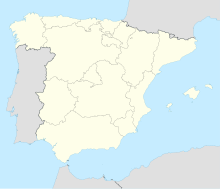Jurassic Museum of Asturias

Exterior view of Jurassic Museum of Asturias
|
|
| Established | March 2004 |
|---|---|
| Location | Principality of Asturias File:Flag of Asturias.svg |
| Coordinates | 43°30′07″N 5°16′29″W / 43.501897°N 5.274769°W |
| Type | Palaeontology of Mesozoic divisions of Cretaceous, Jurassic, and Triassic periods |
| Visitors | Over 1 million |
| Website | Official website |
The Jurassic Museum of Asturias (Spanish: Museo del Jurásico de Asturias; MUJA) is located in the area of Rasa de San Telmo near the parish (administrative division) of Llastres in the municipality of Colunga, Asturias, Spain. Though the municipality of Ribadesella was initially proposed, Colunga was chosen for the building site in the late 1990s. Several landmarks are visible from the museum including the Bay of Biscay, the Sierra del Sueve, and the Picos de Europa. Strategically located over a mount on the Rasa de San Temo, the museum is in the midst the Jurassic Asturias.
The museum displays and collections cover 3,500 million years, and although they emphasize the three stages of the Mesozoic (Triassic, Jurassic and Cretaceous), information is also presented on the preceding and subsequent periods. Different stages of the Jurassic geologic period and system are on display. Corridors contain over 20 dinosaur replicas; measuring over 12 metres (39 ft) in height, their weight would exceed ten tons if the replicas were real. A rich collection of footprints and fossils found in the Asturian Jurassic coastline from ten paleontological sites are exhibited in the exposition halls and are said to be "the most complete informative and representative collection of dinosaur remains in the world."
Founded March 31, 2004 and representing an investment of 12 million euros, MUJA belongs to the Asturian network of public museums. The museum's goal is to illustrate the factors involved in the composition of life on Earth. The palaeontologist José Carlos García-Ramos from the University of Oviedo leads the museum's scientific team.
The museum is located close to the coastline of the Cantabrian Sea and Llastres, a fishing port. It is bounded by the Sierra del Sueve on the south and the Picos de Europa towards the east. MUJA is on the branch road AS-257 towards Llastres, about 1.5 km away.
...
Wikipedia

